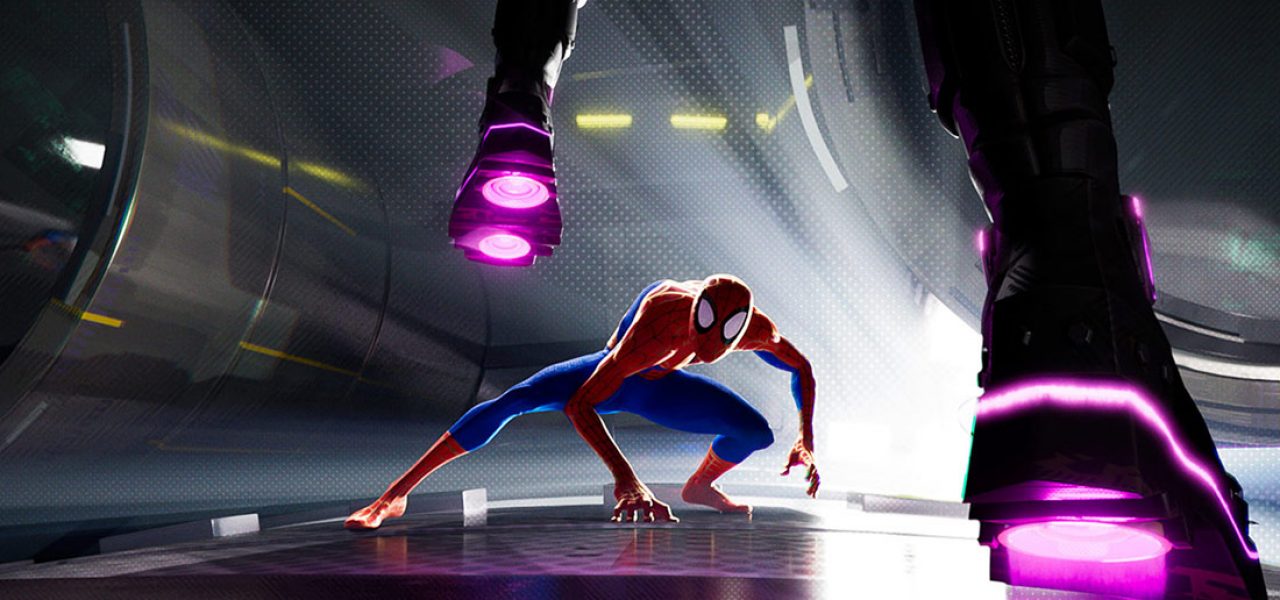
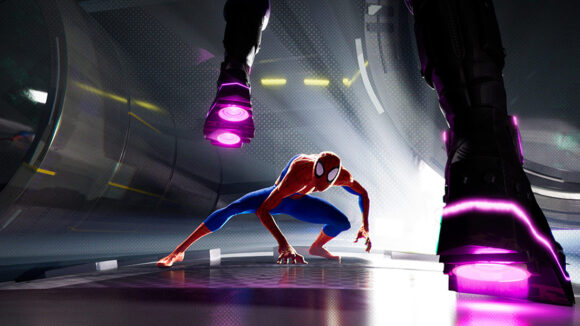
“If We Could Do Anything Our Own Way, What Would We Do?”: A Conversation With ‘Spider-Man’ Co-Director Bob Persichetti
From the moment the world first laid its eyes on a teaser for Sony Pictures Animation’s Spider-Man: Into the Spider-Verse, it was obvious we were seeing something different and unique, but it’s still a surprise just how different and how unique the final film turned out.
To say that there has never been a mainstream American cg feature that looks and feels like Spider-Man would be an understatement. At every juncture of the production process, the filmmakers pushed against the traditional pipeline of cg animation production to, in the words of co-director Bob Persichetti, “counter the inadequacies of cg and let the things that were a weakness become our strength.”
The visionary endeavor took place across two studios — first with the pre-production team at Sony Pictures Animation in Culver City, California, and then at the production studio Sony Pictures Imageworks in Vancouver, Canada. As Persichetti explained, the production was a game of, “Let’s paint ourselves into a corner, and let’s find a creative solution out of that corner.” It’s the type of radical experimental spirit that one expects perhaps from a a short film, but rarely witnesses in the context of a $90 million studio feature.
When I visited Persichetti at the Sony Animation studio in mid-October, the film was racing to the finish and the director’s area was a hive of activity. Thanks to our interview, Persichetti was running late to an Act III battle review with the film’s co-writer and producer Phil Lord. A forlorn burger sat uneaten on his desk, getting colder by the minute. I’d requested an interview during the throes of production because I thought it would make for more interesting conversation, but as I sat in his office, I could feel the stress of production. Was I taking up valuable time that he should’ve been using to actually make the film? Don’t worry, Persichetti reassured. “This is like the most relaxed moment I’ve had in days, weeks, maybe a year.”
In our conversation, we spoke about the film’s unconventional directorial structure (Persichetti shared directing duties with Peter Ramsey and Rodney Rothman), its huge animation crew (possibly the largest that has ever worked on a cg animation feature), how Persichetti and the rest of the crew challenged the conventions of cg animation production, and why Sony Imageworks was the only studio capable of making such an experimental animated feature.
Cartoon Brew: I just saw some of the footage from the film and I’m amazed by what you got away with. How’d you guys do it?
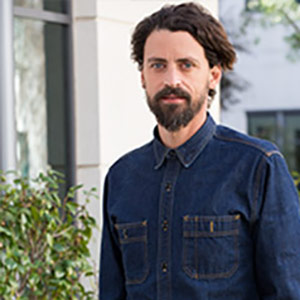
Bob Persichetti: There were many factors that pulled together to allow us to go as far afield as we did. And I think one of them was because it was another Spider-Man movie. It was like, “Why make another Spider-Man movie?,” which initially was my question when they approached me. They didn’t even pitch me that it’s actually going to be Miles. So, then when I read the treatment, I was like, “Oh, it’s Miles…fantastic.” And then, it’s more than just Miles; it’s the Spider-Verse and there’s a handful of other characters that we’ve folded into it. But that was the impetus: we have to make something different enough. There’s a standardized sort of system in feature animation to make it so that what you get out of it looks kind of standardized. There’s obviously beautiful stuff out there, and there’s been amazing films — and I’ve been part of them as well — but this was the opportunity [where] if we could do anything our own way, what would we do?
At what point did you decide you’re going to try to do something radically different and experimental? Was that an initial discussion with producers Chris Miller and Phil Lord?
Bob Persichetti: That was definitely the task. We get to make a Spider-Man movie animated so we can look at the source material — the comics — and pull from that, and we can find a visual language that feels like it’s derivative of a comic book. That was always something early on — let’s make something different. In practice, it was, “Okay, how do we do that?” And then we started to break apart even just printing process and how you represent something simplified like lighting or the inking of the characters. How much you can accomplish with a single pose. All of those little bits and pieces went into this big aspirational target, and we started to just experiment.
And then we [said] let’s strip out all the stuff cinematically that is baked into all the films of today, even live-action, which is stuff like motion blur, rack focus, and in animation, everything is on ones. You have to run all these simulations for hair and fabric, and the pipeline demands that you have a new image every single frame that’s moving so that these simulations can work. That was when we started to really push against the machine because they had to come up with new simulations that worked for animation that’s on twos. If we’re not going to have motion blur, then how do we do camera moves because we’re not going to lock the camera down every time?
So we came up with all these different devices to counter the inadequacies of cg and let the things that were a weakness become our strength. It all coalesced — we started to see some animation tests that were moving with the crunchy texture that we were hoping to find. And then Justin [Thompson] as our production designer was amazing, and we had an amazing visual development team that were doing paintings for two years just trying to figure out how to represent shapes and light graphically, but on top of cg elements, because we still wanted to be able to move the camera.
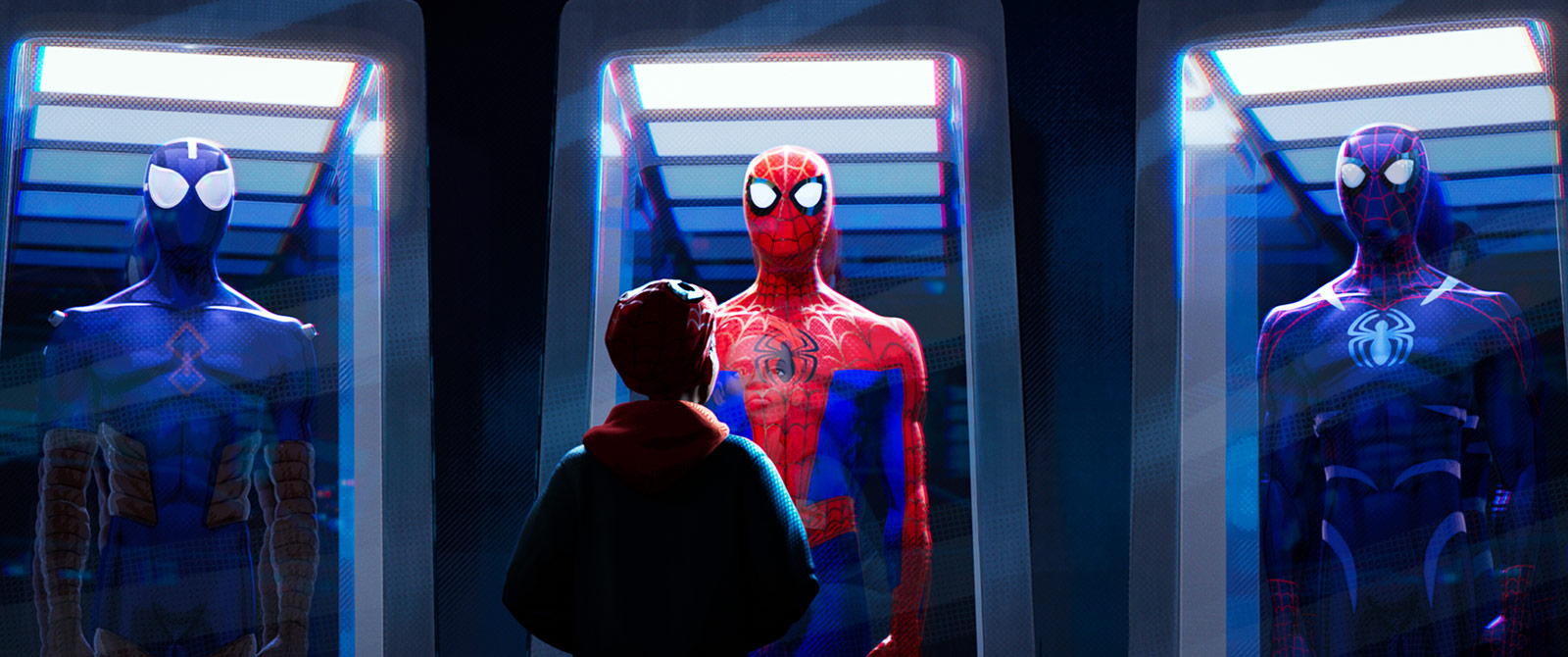
So you did a lot of the visual development here at Sony Pictures Animation, and then you give it to Imageworks and say, “Replicate this. This is what we want.”
Bob Persichetti: Exactly. There was Danny [Dimian], our vfx supe, one of their best guys up there, just a seasoned pro and been on a million movies. He was like, “I just have some reservations. If we don’t have that…this is what you’re going to want…” It was like okay, let’s paint ourselves into a corner and let’s find a creative solution out of that corner. So we came to them with all these sort of ‘asks’ and these aspirations that initially for them were like, “We can’t do that. I promise you when you see that on the screen, you’re not going to want it.” And we were like, “Well, let’s see it and then let’s move from there.”
So they ended up doing our actual testing – the physical mocking-up of a shot, the anim tests — and then we saw the issues and started to make workarounds for the issues. One of the biggest issues aside from pipeline was just the people that we needed to do this stuff. The idea of animating on twos for a lot of our animation crew was completely foreign to them. They’re younger kids who have not ever done hand-drawn animation so the concept of every other frame and key pose and all that stuff was a little bit soft for them. So there was a learning curve there as well.
You have three directors on the film. Who came on first?
Bob Persichetti: I came on three years ago, in 2015…
Because I remember you were announced for On Animation’s Playmobil project before this…
Bob Persichetti:I’ll give you a tiny quick backstory. I pitched Playmobil here, with the Frenchies that had done The Little Prince. Wrote a treatment for that, wrote a script for it. Pitched it here. Sony was trying to buy it. That deal fell apart with the French company, but I wasn’t exclusive to those guys or anything. I was just attached to that specific project.
So you were trying to do Playmobil at Sony?
Bob Persichetti: Yea, and it was happening; they were making a deal, and it all sort of fell to pieces. And it was at the tail of that that they said, “What do you think about Spider-Man.” And I was like, “I haven’t really been thinking about Spider-Man.” And they told me Phil [Lord] and Chris [Miller] had written a treatment and we’d love for you to read it. That was my introduction to those guys because I’ve never worked with them.
So I came on in the beginning of December in 2015. And we had no script yet. It was early. I think we had a loose first act that Phil had been pecking away on, and then over the next six months, we had a full draft and we were boarding simultaneously and getting stuff up on reels.
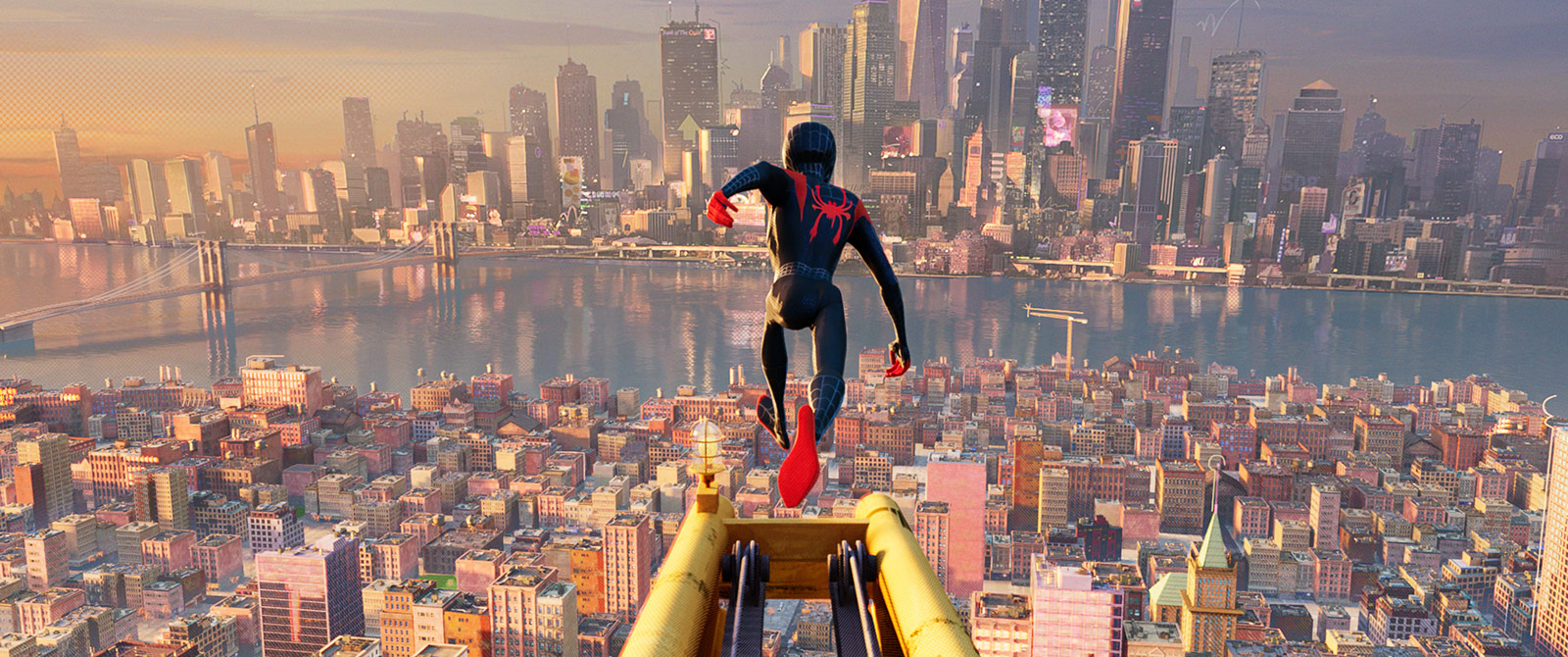
How did the other two directors get involved?
Bob Persichetti: I’d worked with Peter [Ramsey] a bunch before, and he was developing another project for [Spider-Verse producer] Avi [Arad] as the director. So Peter and I had a history, and I was like, “Hey dude, I’m doing Spider-Man. You gotta do boards for me at least.” So I would just give him scenes and he would do boards. He and I always worked really well together, and this project was so time consuming – there was always a sense that I know I’m going to need a partner and Peter’s perfect for it. This is his wheelhouse. So Peter came on as another director I think at the end of 2016.
There was the time when Phil was MIA because of Solo and all this stuff, and we needed to iterate the script, and we were looking for another writer. Rodney [Rothman], who had done a bunch of stuff for them on the Jump Street movies, he came on as just a writer, and then when everything started to snowball, he came on as writing support and directing, and Peter and I all folded in together and went, “Okay, how are we going to do this?”
Now typically a writer on a film doesn’t become a director…
Bob Persichetti: No, [but] also I think he really wanted to direct and we didn’t have a writer that Phil could fully endorse except for Rodney. Because a lot of writers in animation, they’ll come with directors to editorial, and they’re going to write while we’re cutting, and we’re going to get alts written, and it’s a really organic process, and I think [Rodney] wants to direct beyond this, so he said, “I’ll give you the time you want, but I want to direct as well.” We had a little bit of a roundtable meeting with Phil, Chris, and our producers, other producers, and it was like, Okay, Rodney’s going to come on as the third director. Obviously, initially Peter and I were, “How’s this going to work?”
It’s not common…
Bob Persichetti: No it’s not.
So I’m curious if you could explain a little about the hierarchy and structure of that setup…
Bob Persichetti: The structure became almost like stop-gap measures, in a super simplistic way. It was like, writing support is happening here…you’re in edit…we’re trying to get through these scenes in animation…let’s come back to edit to do this…it was divide and conquer. And when we would all be together in editorial, it became a moment for us to make sure we were all on the same page and make sure we were all making the same movie, because we were so busy. Honestly, our animators were averaging a foot of animation a week, which is like really bad. So we were grinding, just trying to get up to speed. It was pretty intense, pretty crazy, and somehow we all managed to just get along, which is kind of shocking. (laughs)
That’s really interesting that it all worked out. I mean, I know of recent animated features with just two directors where the directors can’t stand each other.
Bob Persichetti: Luckily, Peter and I have been friends for so long, that was a no-brainer. Rodney and I became friends on this project and we’ll be friends afterward.
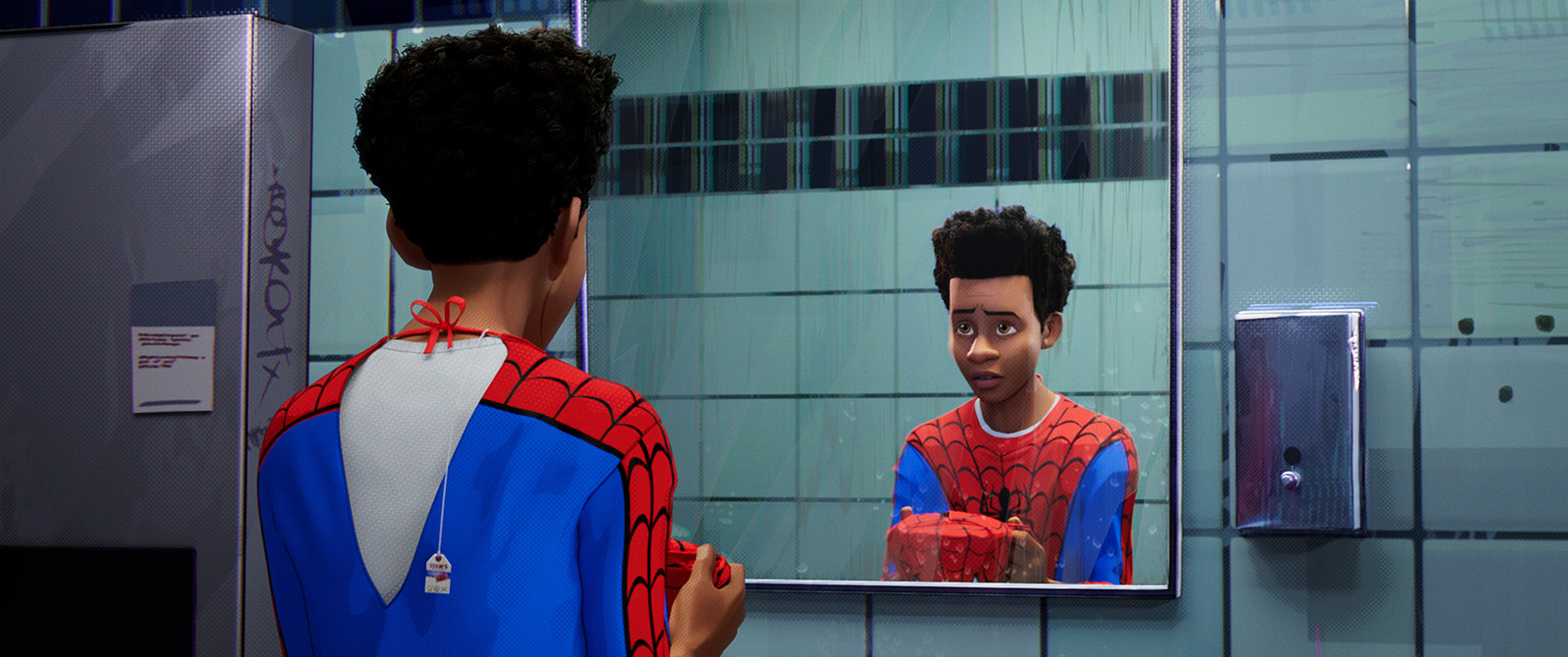
And then on top of that, you have two other strong-willed directors, Phil Lord and Chris Miller, who are producing the film. How were they involved throughout this process?
Bob Persichetti: More than [Chris] Miller, it’s been Phil’s baby because he wrote the first draft. Not that Chris isn’t involved, but he’s also got Lego 2 that they’re working on. So there’s sort of a divide and conquer between the two of them that happens. But in a weird way, it ends up probably working a lot more like a writer’s room creatively in that you need a quorum. It’s like…I vote for this one…I vote for this one…oh wow, that’s crazy we’re all on the same page. Or…I really believe in this idea. Well tell me why. Okay, I get that…let’s put that in our next preview and see if it flies.
Phil had this both inspirational but also ridiculously absurd line of, “Hey I think the movie’s just going to tell us what it wants to be.” And I’m like, “I hear you…okay…” And in a weird way, yes, we presented things and we put things in the movie and there are certain things that the movie rejected. And it was kind of obvious. And then there were other things where it’s like…I don’t think the movie is rejecting that, but you might think it is. We definitely had lively conversations.
It’s a testament that you guys you made it work. What I’ve seen is a cohesive vision and you often don’t feel that when you’re watching a film made with multiple directors. In animation, you think you always need the one visionary director, and you guys have shown that a team can make something that represents a unified vision.
Bob Persichetti: Yea, I think the irony of it is that it’s a little bit part of the thematic message to the movie: Finding a team, finding others like you. That’s inherent in Miles becoming Spider-Man in a universe where there already is a Spider-Man and then other Spider people show up too. It’s like: “Oh my god, I’m not alone, I’m not the only teenager going through this.” So in a weird twist of fate, we were all experiencing our own version of this movie in real life, where as the guy who came on first, [it was like] oh, I’m going to have a directing partner, rad; oh I’m going to have another directing partner, wow this is kind of crazy. Will this ever work? I have my doubts. And then I was pleasantly surprised.
Obviously we’re all pretty passionate people, and we’re making something that requires a lot of passion to see through. And that includes Phil and Chris. We’ve all really gone to bat for things in a way that we can all be proud of. And if conflict arose out of it, within a day or two, it was all gone and we were stacked hands again and moving forward. It was my own lesson in working with others.
And we had such a huge crew. At one point our animation crew was like 172 people, which is just absurd. I was in anim reviews for like seven hours a day. It was just like, “I gotta get off this couch [and take a break from reviews].”
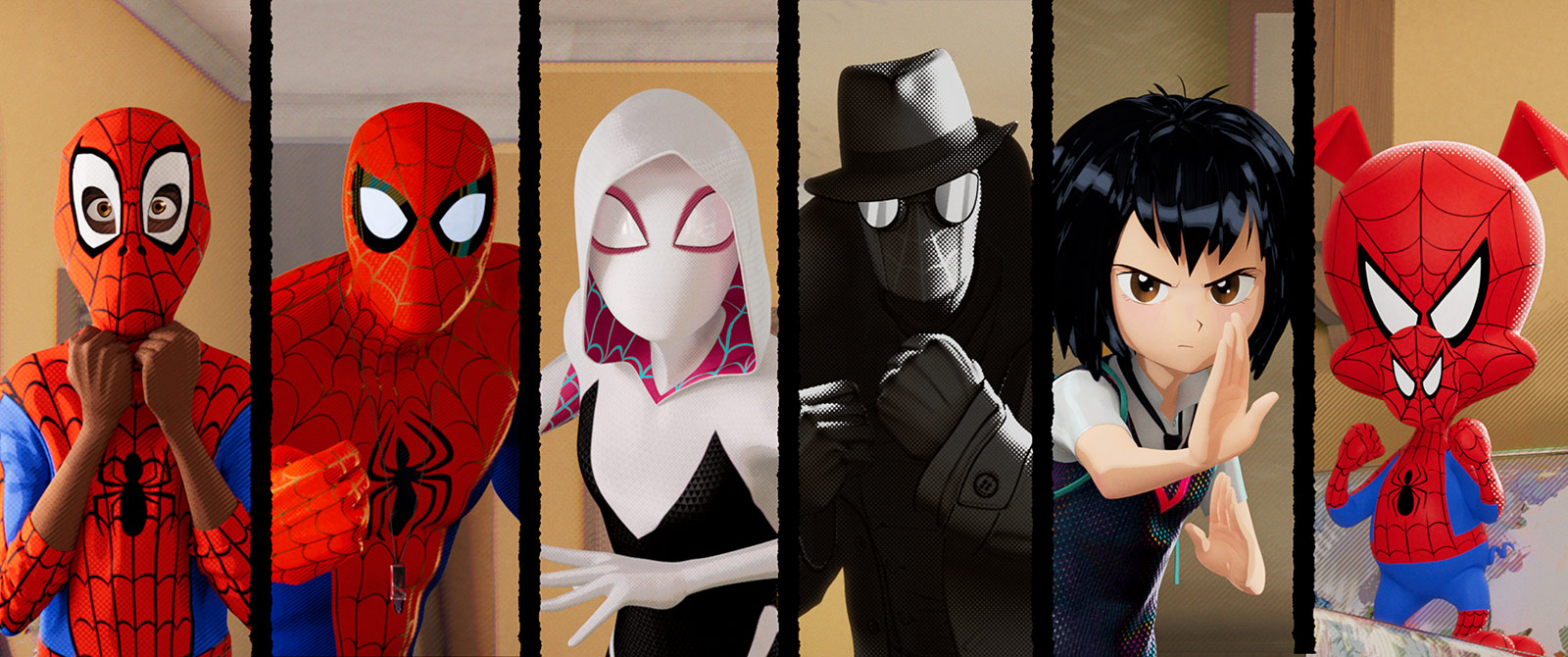
Why was the animation crew so large?
Bob Persichetti: Because the footage was so low. (laughs)
But why was the footage so low…
Bob Persichetti: Footage was so low because we did this thing where we made all our models sculptable. I’ve been in animation a really long time; I was lucky enough to assist Glen Keane on Tarzan and Treasure Planet, and I worked with Andreas Deja. I got a crash course in traditional 2d animation, and so I saw what you can achieve with a drawing — and how a computer and a computer model and keeping things on model limited that in a way.
So if we took this concept of, “Hey, the cool thing about a comic book is that every single panel is to camera and is as expressive and as dynamic as one pose can be,” and we tried to do our animation with that as the philosophy behind it, then we can’t be confined to the model staying exactly the same. So we built in this ability to basically sculpt all our models. We’ll do a rough pass in the anim and part of the clean-up of that would be going in and adding straights into areas where if you were drawing it, you would just put a straight. So there was a lot of detail work.
Just so I understand, there’s multiple models of the character…
Bob Persichetti: No, it’s one model that’s flexible. So, if you look at our animation, it doesn’t have a lot of noticeable squash and stretch in it. The idea behind that was if we want something to have the equivalent of squash and stretch, let’s telescope it. So the leg all of a sudden goes three times longer for one or two frames.
We started to come up with all these little substitute versions of the rules of animation, so that in texture and feel it felt different, but it still achieved the same goal — to either feel weight or anticipation or impact or things like that. All of those things were hard to learn because they were all out of the box for our whole crew. And they all dove in. That was what was rad. It was like, “Here’s the challenge. Yes, I know this is the tenth time we’ve reviewed this shot, but I have more notes. We’re going to get there and it’ll speed up.”
It just took a long time to ramp up and really catch our stride. This movie has something like almost 2,800 shots in it, which is a lot for one of these movies. When you saw how there’s panelization on the screen, each one of those panels is a separate shot. There’s three seconds, but there’s three panels, so it’s nine seconds of [animation]…it’s exponential. We’ll probably have a post-mortem of this thing where we try to figure out exactly all the things that we did because we were kind of going on the fly and reacting to what we were seeing, so some stuff we didn’t plan. And then we just went, “Ooh! I like that. How do we do more of that?”
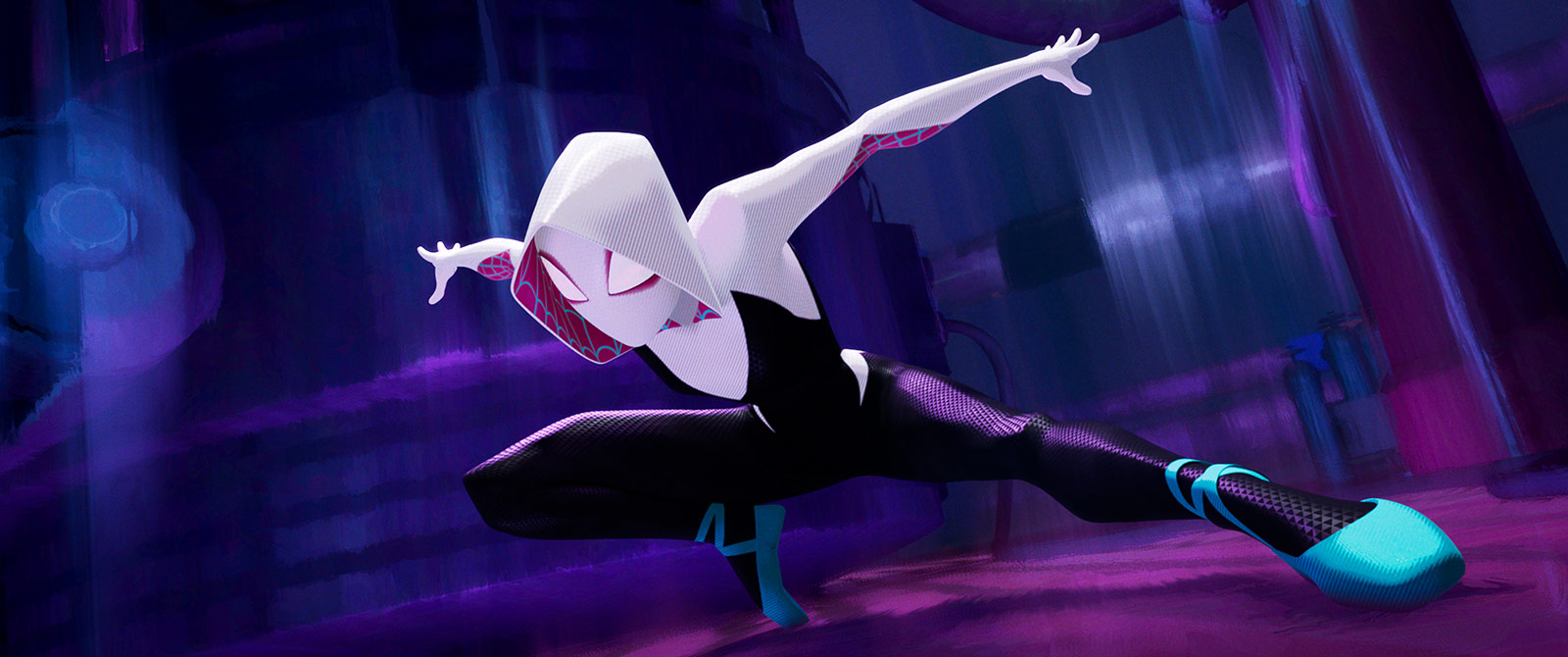
I want to follow up on a comment you made about coming from a traditional animation background. Can you talk a little bit about what you gain and what you lose when working in cg animation compared to working traditionally?
Bob Persichetti: At the core of it, the part where we’re sitting in editorial and trying to make the reels work, that’s all the same. So, the narrative stuff is all the same — wanting to find really engaging characters that are on a compelling journey. Everything else, it might have the same department name on it, [but] totally different.
Alberto Mielgo was one of our super early painter/designers and he was a big proponent of, “I don’t want to build sets; let’s just paint all the backgrounds.” And that’s fantastic, but we can’t proceduralize it; we can’t make a feature like that. But that’s the spirit that this movie needed to have.
In that sense, there can be some things that happen today that are kind of limiting because while it’s animation, the most expressive medium you could hope for in film, when you do it on a computer, and you have to build a city, especially like New York, it might be in a computer, but it’s real and you start to put restrictions back on top of you that are like live-action. And that stuff is the stuff that we were really trying to push against. How do we make this movie feel like we went around the streets of New York and we shot in New York without building the entire city in a computer.
Before, if you could draw it, it could be onscreen. Now, you have to build it, and you have to build it in a way that you can either re-purpose it — and we’re speaking about budget issues, but that it’s going to be used enough that it’s worth the time to build. So one-off set-ups are super expensive and [the lack of that option] becomes limiting for you. That’s part of the difference between 2d and 3d is that strangely enough 3d put handcuffs on you.
Cg has created this really efficient pipeline that allows people to be super expressive and fluid with their performances, but in the same way that you have to build the city, you now have to live within the character. That character is that character, and as soon as you start to play and pull with it, it looks off-model. And it needs to still move in this fluid way because we need all those frames to do all these other things that the computer desires, for lighting and cloth and fx. So it started to feel homogenized.
That was probably the biggest pushback. It was like, “Wait, you want to do what for this one shot?” Yeah, how do we do that and maybe we do it in four shots, but we don’t want to rebuild a new model, so we were always finding workarounds. And in a weird way, I think the only place that could handle a feature like this was probably Imageworks, just because they’re a vfx studio and they’re used to a vendor-vendee relationship, so they’re like, “Ok, we have to figure it out.”
Whereas if we were at Dreamworks, Disney, or Pixar, I think they would’ve just been like, “The animation department is run by this person and this is how it works, and this is what lighting needs, so we have to satisfy those needs.” [With Imageworks], we just went, “You have to satisfy our needs!,” like spoiled kids but with a purpose.

.png)